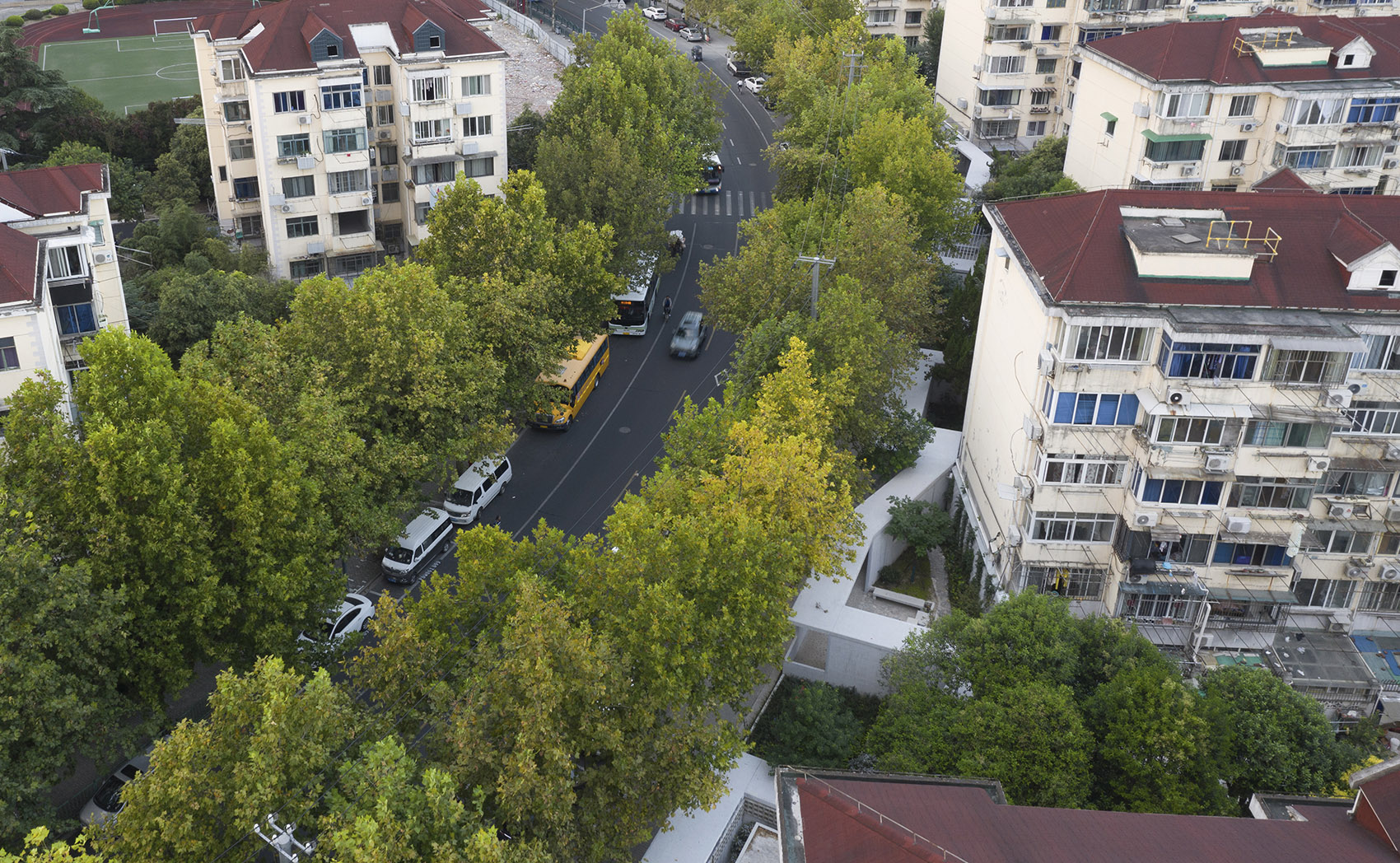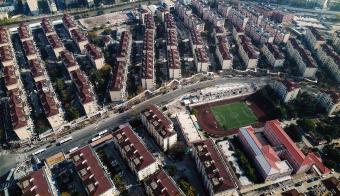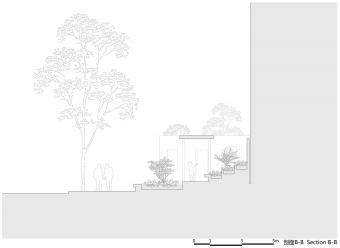上海昌里园景观设计 | 梓耘斋建筑
-
项目名称:上海昌里园景观设计
-
项目地点:上海市浦东新区南码头路
-
项目规模:2100㎡
-
设计公司:
-
施工单位:上海浦东新区三林城乡建设发展有限公司
-
委托方:上海浦东新区周家渡街道人民政府
-
建成时间:2020年5月
周家渡街道位于世博园区的南侧,是一片高密度的生活街区,拥有许多非常典型的大型居住社区,呈半弧形延展的南码头路从其中穿越而过。
Located in the south of the Expo Park, Zhoujiadu Street Neighborhood is a high-density living block with many typical large residential communities. The semi-circular Nanmatou Road,where the project is located,passes through it.

▲项目鸟瞰,aerial view of the project ©梓耘斋建筑
2018年的拆违整治项目,将南码头路东侧喧闹杂乱的商业店铺拆除清理,在昌五小区的边界处留下了一段350多米长的圆弧形围墙绿地,面对城市形成了一道单调、冗长的界面,而在小区内部也留下一段段荒芜封闭的杂草丛生地。如何重塑这道城市边界,激发街道生活,便成为这个项目的迫切议题。
In 2018, Shanghai began demolishing illegal buildings. As a result, all illegal commercial stores on the east side of Nanmatou Road were removed, leaving a 350-meter-long curved green space at the boundary of The Changwu Community. The boundary became a monotonous and lengthy fence in the city and enclosed a barren and obsoleted wasteland inside the community. Therefore, how to reshape the city boundary and stimulate street life has become an urgent issue for this project.


▲改造前基地原貌,original view of the site before renovation ©梓耘斋建筑

▲改造中的围墙鸟瞰,aerial view of the walls under construction ©梓耘斋建筑
昌五小区建造于上世纪90年代,是一处高密度的居住小区,小区内部并不宽裕的楼间绿地大多用于解决停车问题,并没有为社区公共活动留下空间,居民的日常休闲几乎无处可去。因此,借由社区围墙的重修,为小区公共环境的修复与改善提供一个契机,就成为这个项目的设计初衷。
Built in the 1990s, Changwu Community is a high-density residential area. The greenbelt between buildings within the community is mostly used to solve the parking problem, leaving no space for community public activities, and residents have almost no place to go for daily leisure. Therefore, the original intention of this project is to provide an opportunity for the restoration and improvement of the community’s public environment through the regeneration of the walls.

▲局部鸟瞰,凹凸的界面提供公共活动空间,partial aerial view, zigzag walls providing space for public activities ©梓耘斋建筑
从这一角度而言,苏州园林可以为这一项目提供借鉴。沧浪亭面对葑溪的城市界面,由于采用复廊围墙,而显得灵动,富有生气;拙政园东院的波形廊上下起伏,本身就成为了一道亮丽的风景特写……于是作为城市边界的昌五社区围墙,同样有机会成为一处富有生活气息的线型园林,使得这一条6-8m宽窄不等的空隙地,从小区的边缘转变成为这片社区的中心花园。
The construction wisdom of Suzhou gardens acted as a reference for this project. The urban interface of the Canglang Pavilion facing the Fengxi Stream is dynamic and full of vitality due to the double corridor design. The winding corridors of Humble Administrator’s Garden makes itself a beautiful landscape… Therefore, as the boundary of the neighborhood, the wall of Changwu community also has the opportunity to become a linear garden that accommodates daily street life. The goal of this regeneration project is to transform a 6-to-8-meter-wide margin into the central garden of this community.

▲设计分析,design analysis ©梓耘斋建筑
改造设计中首先确立了折线型的游园路径。根据沿街住宅楼的排列,围墙内外的树木环境和街道功能,游廊的走向相应地内外凹凸,不仅与小区内部的环境形成呼应,扩展视野,同时也在为街道提供拓展性的口袋空间。这样每一处的段落空间在获得功能性价值的同时,也将小区内外的环境交织起来,在无形之中也就消解了围墙所带来的隔断感,使这道围墙园林成为内部社区居民和外部街道游客都能获得参与感的中心性场所空间。
In the regeneration design, the zigzag walkway is established at first. According to the location of the residential buildings along the street, the trees near the wall, and the functional nodes on the street, the path of the corridor was formed correspondingly. The design is not only an extension to the internal environment of the community but also an expansion of the sidewalks by providing pocket gardens. In this way, each space not only has functional value but also interweaves the environment inside and outside the fence, which eliminates the sense of isolation brought by the fence, making this wall & garden a central place where both residents in the inner community and tourists in the outer street can get a sense of participation.


▲改造前后空间轴侧对比,axonometric before and after renovation ©梓耘斋建筑
游廊的曲折错动容纳了因地制宜布局的场所节点:它们有些是为了买菜回家的居民提供休息的敞廊,有些是为了小区入口提供的缓冲地带,有些是为了放学儿童提供的读书庭院,有些则成为老年人相聚聊天的街头会客厅。
The dynamic form of the corridor accommodates various functions: some of them provide a rest space for residents to go home to buy vegetables, some provide a buffer zone for the entrance of the community, some provide a reading courtyard for children after school, and some become a street meeting place for elderly people to gather and chat.


▲沿街界面,interface along the street ©上:田方方,下:梓耘斋建筑


▲道路与小区之间的缓冲区域,buffer space between the residential community and the street ©田方方

▲休闲聚会空间,leisure gathering space ©田方方
园林中所经常采用的因借体宜、随类赋彩的策略,也被用来应对在社区工作中所必须面对的不确定因素,这样的策略使得昌里园在实施过程中,可以根据居民的意见进行积极调整,也可以将公交车站候车功能等周边因素灵活地纳入其中,但同时也不损失原有的,富有园林意趣的理想场景。
In this project, the strategies often adopted in garden design, such as “interdependence [因], borrowing [借], suitability [体], and appropriateness [宜] as well as coloring by the categories[随类赋彩],” are used to deal with the uncertainties that must be faced in construction work within a community. Such strategies enables the design team to make dynamic adjustments according to residents’ feedbacks in the implementation process, and flexibly incorporate surrounding factors such as bus station waiting area into the design without losing the original ideal scene.



▲富有园林意趣的场景,strategies in traditional Chinese garden design adopted in the project ©上:田方方,中/下:梓耘斋建筑
作为一种兼具美好愿景和灵活操作的园林策略,在昌里园的实践中得到了充分的呈现。它不仅作为一种设计手法,将各方面的不同因素融合成为一道风景,而且也将由于它所激发的社区共同参与,为将来进一步的社会交融发展打下一个坚实的基础。
The practice of Changli Garden showcases the strategies of garden design combine good vision and flexible operation. As a design technique, it not only integrates various factors into a landscape, but also stimulates community participation, which lays a solid foundation for the further development of social integration in the future.

▲南段平面图,plan of the south part ©梓耘斋建筑

▲南段立面图,elevation of the south part ©梓耘斋建筑


▲剖面图,sections ©梓耘斋建筑

▲细部,details ©梓耘斋建筑
项目名称: 昌里园
建筑事务所: 梓耘斋建筑(TM Studio)
主创建筑师: 童明 任广
设计团队: 郭鴻衢 杨柳新 谢超
项目详细地址: 上海市浦东新区南码头路
景观用地面积:2100㎡
业主: 上海浦东新区周家渡街道人民政府
施工团队:上海浦东新区三林城乡建设发展有限公司
项目配合:上海市浦东新区规划建筑设计有限公司
设计时间:2019年4月-9月
建设时间: 2019年10月-2020年5月
建筑面积:景观构筑物790㎡
结构形式:钢框架结构
Project name: Changli Garden
Design: TM Studio
Principal Architect: Tong Ming Ren Guang
Design team: Guo Hongqu, Yang Liuxin, Xie Chao
Location: Nanmatou Road, Pudong New Area, Shanghai
Landscape area: 2100㎡
Client: People’s Government of Zhoujiadu Street, Pudong New Area, Shanghai
Collaborator:Shanghai Pudong New District Planning Construction Design Co.,Ltd.
Project Construction: Shanghai Pudong New Area Sanlin Urban-rural Construction and Development Co., LTD
Design Duration: From April to September, 2019
Construction Duration: October 2019 – May 2020
Building Area: 790㎡ of landscape structure
Structural form: steel frame structure
版权声明:本文版权归原作者所有,如有侵犯您的权益请及时联系,我们将第一时间删除。
投稿邮箱:contact@landscape.cn
项目咨询:18510568018(微信同号)



























